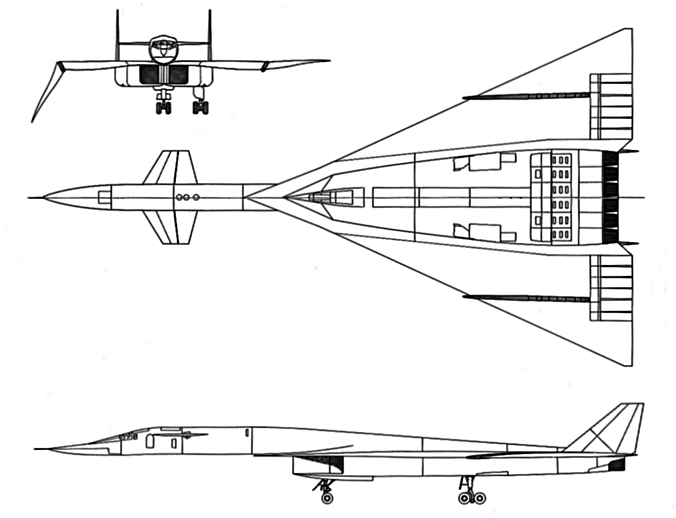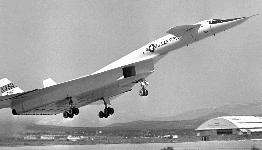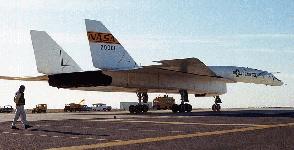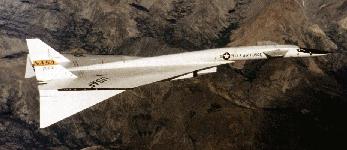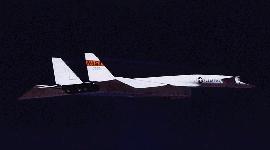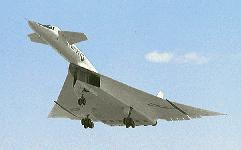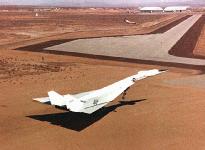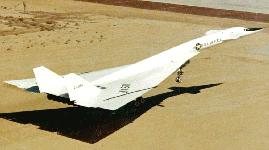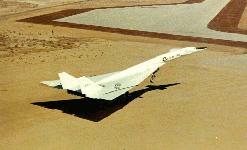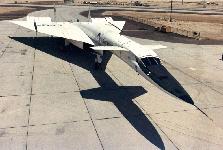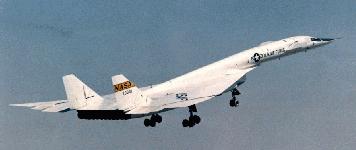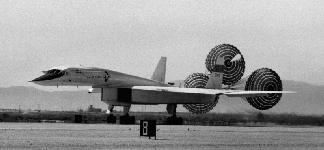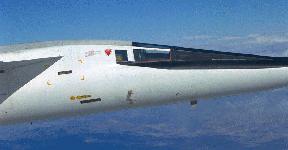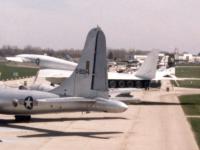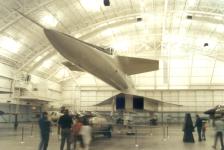B-70 Valkyrie
With research and development studies beginning in 1955, the XB-70 was a large, long-range strategic bomber was planned to be the replacement for the B-52. As in the B-58 program, the Air Force wanted new technology advances. To this end, the Air Force gave the prime contractor total weapon system responsibility. Competition between Boeing and North American for the contract occurred during the design phase. In 1958, the North American design was chosen and a development contract awarded. The Air Force requirement was for a Mach 3, high-altitude, long-range bomber capable of carrying nuclear and conventional weapons.
Although there was a technology breakthrough in 1957 that made Mach 3 possible, the XB-70 never went into production. The continuing emergence of new SAMs was the key factor in the demise of the XB-70, just as it affected the B-47 and B-58.
The XB-70 had a length of 196 feet, a height at the tail of 31 feet, and an estimated maximum gross weight of 521,000 pounds. It had a crew of four: pilot, copilot, bombardier, and defensive systems operator. The delta wing had a span of 105 feet with six turbojet engines side by side in a large pod underneath the fuselage. The wing was swept at about 65 1/2o, and the wing tips were folded down hydraulically 25o to 65o to improve stability at the aircraft's supersonic speeds of up to Mach 3. At this speed the Valkyrie was designed to ride its own shock wave. A large canard foreplane near the front of the fuselage with a span of 28 feet, 10 inches was used for stability. In addition to its sharply swept delta wings, the XB-70s had two large vertical tails.The aircraft was fabricated using titanium and brazed stainless steel �honeycomb� materials to withstand the heating during the sustained high Mach number portions of the flights. The propulsion system consisted of six General Electric turbojet engines (J93-GE 3) with two large rectangular inlet ducts providing two-dimensional airflow.
The entire mission (including return) was to be flown at Mach 3, but even then the aircraft was vulnerable to SAMs of the 1960's vintage. A high altitude, Mach 3 penetrator cannot maneuver well; its straight and level trajectory would have been an easy course to plot and intercept. Further, the technology that made Mach 3 possible yielded an airframe with a large RCS that added to the effectiveness of SAMs against the XB-70. The airframe was not adaptable to low level penetration to avoid SAMs because the delta wings were very thin and did not lend themselves to the structural modifications necessary for sustained, low level flight.
The XB-70 design had payload flexibility but not mission flexibility. In 1959, the XB-70 concept was changed to a recon/strike RS-70, making it a reconnaissance aircraft with a bomber strike capability. However, its reconnaissance capability would not have been as good as the super high altitude aircraft designed to fill the reconnaissance role. The XB-70 was an aircraft which fulfilled the criteria it was designed to meet, but whose mission had been eliminated by defensive threat technology.
The high drag of the Mach 3 airframe required a fuel load comparable to the B-52 but limited the range to about 5,000 nm. It was capable of carrying both conventional and nuclear weapons internally, but due to its design and Mach 3 mission profile, it could not carry external ordnance.
In 1961, President Kennedy announced that the XB-70 program was to be reduced to research only, citing high cost (over $700 million per prototype) and vulnerability. The Kennedy administration felt ICBMs were more cost effective because they were less vulnerable and were cheaper operationally. Although two XB-70 prototypes were built, with the first flight in 1964, the program terminated in 1969. The XB-70 had speed, range, and adequate payload, but it was expensive, not suited to low level penetration, and thus did not compete with ICBMs for strategic funds.
During the early 1960s, the NASA Flight Research Center was involved in support of the national Supersonic Transport Program (SST). Two prototype Mach 3+ high altitude bombers, built by North American Aviation for the Air Force, became available for SST research with the cancellation of their intended military program. Aircraft No. 2 (serial # 62-0207) with its improved wing design, was capable of sustained Mach 3 flight at altitudes around 70,000 ft. This highly instrumented vehicle was destroyed in a mid-air collision with NASA F-104N (N813NA) on 8 June 1966. An attempt to substitute the slower No. 1 aircraft (serial # 62-0001) into the research program met with limited success. Ship #1 was flown by the NASA Flight Research Center (now NASA Dryden), Edwards, Calif. from March 1967 through early 1969. The XB-70A program produced a significant quantity of information about supersonic flight up to Mach 3 speeds. In many areas, such as noise (including sonic boom runs), clear air turbulence, flight controls, aerodynamics and propulsion system performance and operation problems, it related to SSTs.
Specifications |
|
| Span: | 105 ft. |
| Length: | 185 ft. 10 in. without boom; 192 ft. 2 in. with boom |
| Height: | 30 ft. 9 in. |
| Weight: | 534,700 lbs. loaded |
| Engines: | Six General Electric YJ-93s of 30,000 lbs. thrust each with afterburner. |
| Maximum speed: | 2,056 mph. (Mach 3.1) at 73,000 ft. |
| Cruising speed: | 2,000 mph. (Mach 3.0) at 72,000 ft. |
| Range: | 4,288 miles |
| Service Ceiling: | 77,350 ft. |
